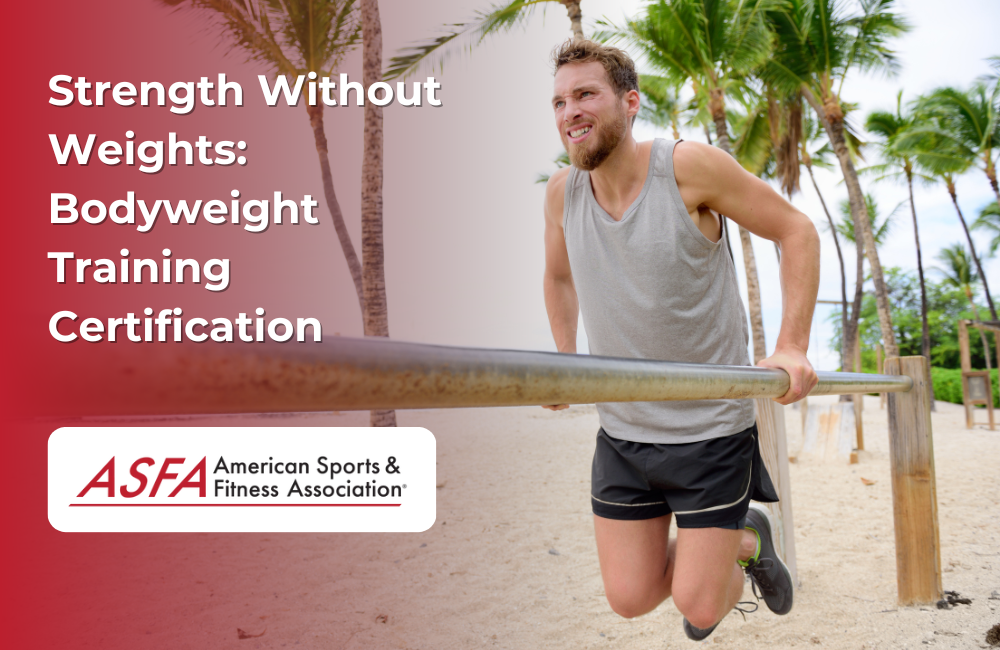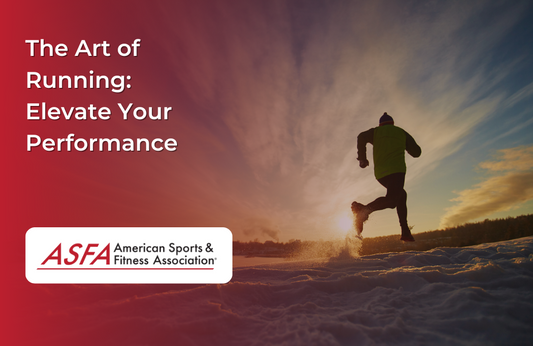Earning a Bodyweight Training instructor certification is an empowering journey that enables fitness professionals to harness the power of bodyweight exercises to help individuals achieve their fitness goals. This guide outlines the essential steps and considerations for obtaining your certification and becoming a trusted fitness professional in this versatile and increasingly popular field.
Bodyweight training, a practice that utilizes the body’s natural resistance for strength and fitness, is more than just a workout—it’s a dynamic, functional approach to health that promotes strength, flexibility, and endurance. Bodyweight exercises can be as effective as traditional weightlifting to build muscle, emphasizing the importance of progressive overload and proper recovery. As a certified instructor, you’ll not only teach physical exercises but also inspire others to unlock their body’s potential. Strength Without Weights is your roadmap to becoming a skilled bodyweight training instructor, offering insights into the certification process, principles of training, and the path to success. Strength training is a fundamental aspect of fitness, and bodyweight exercises play a crucial role in developing strength and muscle without the need for weights.
Part 1: Understanding Bodyweight Training Certification
A Bodyweight Training instructor certification is a formal recognition of your ability to teach and design effective fitness classes using bodyweight exercises. It signifies expertise in a growing discipline that requires minimal equipment, making it accessible to people of all fitness levels. Through this certification, you’ll be able to instruct participants in movements that enhance strength, flexibility, and functional fitness using only their own body weight. Bodyweight exercises engage the whole body, contributing to overall fitness and endurance.
Introduction to Bodyweight Exercise
Bodyweight exercises are a versatile and effective way to build strength, muscle, and endurance using your own body weight as resistance. These exercises can be performed anywhere, at any time, without the need for any equipment, making them an accessible option for everyone. Whether you’re a beginner or an advanced athlete, bodyweight exercises can be tailored to meet your individual fitness goals and needs. From push-ups and squats to more advanced movements like pistol squats and handstand push-ups, the possibilities are endless. The beauty of bodyweight training lies in its simplicity and adaptability, allowing you to challenge yourself and progress at your own pace.
Benefits of Bodyweight Training
Bodyweight training offers a multitude of benefits that go beyond just building muscle. One of the most significant advantages is the improvement in overall strength and muscle growth. By engaging multiple muscle groups simultaneously, bodyweight exercises promote functional fitness, enhancing your ability to perform everyday activities with ease. Additionally, these exercises improve flexibility, balance, and coordination, contributing to better overall health and physical performance.
Another key benefit is the low-impact nature of bodyweight training, making it an excellent option for individuals recovering from injuries or those with joint issues. The convenience factor cannot be overstated—since bodyweight exercises require no equipment, you can perform them anywhere, whether at home, in a park, or while traveling. This accessibility ensures that you can maintain a consistent fitness routine, regardless of your location or schedule.
What Bodyweight Training Instructors Offer: Bodyweight Exercises
-
Versatility: Teach exercises that can be performed anywhere, with minimal or no equipment, appealing to clients looking for accessible fitness solutions.
-
Functionality: Focus on movements that mimic everyday activities, improving overall mobility, balance, and strength.
-
Adaptability: Design programs suitable for various fitness levels, from beginners to advanced athletes, making fitness approachable for everyone.
-
Lower Body Strength: Emphasize the importance of lower body strength in enhancing overall power and stability. Instructors can help clients improve this through specific exercises like jumping lunges and squats, addressing strength imbalances and engaging key muscle groups in the legs and hips.
Part 2: Steps to Earning Your Bodyweight Training Certification
To earn your certification as a Bodyweight Training instructor, you must follow a series of steps designed to ensure you’re equipped with the necessary knowledge and skills to lead others effectively. This certification will enable instructors to help clients build muscle mass through effective bodyweight exercises.
Research Certification Organizations
Begin by researching reputable certification organizations in the fitness industry. Choose organizations recognized for offering high-quality, Bodyweight Training certifications. Some organizations may offer specialized programs tailored to your career goals, such as bodyweight training for specific populations or advanced techniques.
Choose a Certification Program
Select a certification program that aligns with your aspirations. Certification programs vary, with some focusing on general bodyweight training, while others delve into areas such as sports-specific training, rehabilitation, or bodyweight training for special populations like seniors or those recovering from injuries.
Enroll in the Certification Exam
Once you've selected your certification program, enroll in the certification exam. The exam will typically cover topics such as:
-
Bodyweight Training fundamentals
-
Proper form and technique
-
Exercise programming and progression
-
Safety guidelines and injury prevention
Study and Prepare
Prepare thoroughly for the certification exam by studying the provided materials. It’s crucial to understand the anatomy of bodyweight exercises, the science of building strength, and how to design safe and effective workouts. Understanding how bodyweight exercises contribute to muscle mass and overall strength is also essential. Additionally, familiarize yourself with different exercise modifications to ensure inclusivity for participants of varying fitness levels.
Gain Practical Experience
Practical experience is key to becoming a competent instructor. Start by teaching bodyweight classes or shadowing an experienced instructor. Practicing bodyweight exercises on your own will also help you gain confidence and mastery of the movements. Experience in creating routines and helping participants perform exercises safely will enhance your ability to lead.
Take the Certification Exam
Complete the Bodyweight Training certification exam, which will assess your understanding of bodyweight training techniques, your ability to design effective workouts, and your coaching skills. Success in the exam marks your official entry into the field as a certified instructor.
Maintain Your Certification
After earning your certification, stay current by fulfilling continuing education requirements. This may include attending workshops, obtaining advanced certifications, or completing continuing education credits to keep up with industry trends and ensure you're providing the best instruction possible.
Part 3: Specializations and Advanced Certifications in Strength Training
Once you’ve earned your Bodyweight Training instructor certification, you can further expand your expertise by pursuing specialized certifications. These advanced credentials allow you to offer more targeted programs and expand your professional scope. Targeting gluteal muscles in advanced bodyweight exercises is crucial for overall strength and stability.
Specialization Options: Core Muscles
-
Advanced Bodyweight Exercises: Learn complex progressions like one-arm pushups, pistol squats, and more advanced variations that challenge participants at higher fitness levels.
-
Bodyweight Training for Special Populations: Train specific groups, such as seniors, pregnant individuals, or those recovering from injury, by adapting bodyweight exercises to meet their unique needs.
-
Sports-Specific Bodyweight Training: Focus on bodyweight exercises that enhance performance in specific sports, such as soccer, basketball, or gymnastics, tailoring movements to improve agility, speed, and strength relevant to each sport.
Part 4: The Business Side of Bodyweight Training Instruction
Becoming a certified Bodyweight Training instructor means you're not only teaching fitness classes but also running a business. Understanding the business side of instruction is crucial for long-term success.
Key Business Considerations:
-
Liability Insurance: Ensure you have liability insurance to protect yourself legally in the event of participant injury.
-
Client Waivers: Always have clients sign waivers acknowledging the risks involved in physical exercise and releasing you from liability.
-
Ethical Considerations: Maintain professionalism and ethical conduct at all times. This includes respecting client confidentiality and providing inclusive, respectful instruction.
-
Marketing Your Classes: Whether you teach in gyms, studios, or online, promoting your services effectively is key. Develop a strong brand and use social media, personal websites, and client testimonials to grow your business.
Part 5: Continuing Education and Staying Current for Muscle Growth
The fitness industry is constantly evolving, and staying informed of the latest trends and research is essential to your success. Pursue ongoing education through:
-
Workshops and Seminars: Attend professional development events that keep you updated on the latest techniques, trends, and research in bodyweight training.
-
Advanced Certifications: Consider earning certifications in complementary fitness areas, such as functional movement, nutrition coaching, or mobility training, to broaden your expertise.
Part 6: Launching Your Career as a Bodyweight Training Instructor
Once certified, it's time to launch your career and start building a loyal client base. Create classes that leverage the versatility and effectiveness of bodyweight exercises, offering something for everyone, regardless of their fitness level.
Tips for Starting Your Career:
-
Develop Signature Classes: Create a unique class format or structure that sets your sessions apart from others. Incorporate a blend of strength, endurance, and flexibility exercises to provide a well-rounded workout.
-
Emphasize proper technique: Ensure participants maintain a bent standing knee during exercises to ensure proper form and maximize lower body engagement.
-
-
Create Online Content: Many fitness professionals today offer online classes or training programs. Offering virtual bodyweight classes can expand your reach and help you connect with clients outside your immediate area.
-
Build Client Relationships: Your success as an instructor hinges on your ability to connect with and motivate participants. Focus on fostering strong relationships with your clients and providing a supportive, encouraging environment.
Part 7: Getting Started with Bodyweight Workouts
Embarking on your bodyweight workout journey is straightforward and requires minimal preparation. Here are some tips to help you get started:
-
Start Simple: Begin with basic exercises such as push-ups, squats, and lunges. These foundational movements will help you build strength and confidence.
-
Focus on Form: Proper form and technique are crucial to prevent injuries and maximize the effectiveness of your workouts. Take the time to learn and practice each movement correctly.
-
Warm Up: Always start your workout with a warm-up to prepare your muscles and joints for exercise. This can include dynamic stretches or light cardio activities.
-
Gradual Progression: Start with shorter workouts and gradually increase the duration and intensity as you become more comfortable and stronger.
-
Listen to Your Body: Pay attention to how your body feels during and after workouts. Rest when needed and modify exercises to suit your individual needs and fitness level.
By following these tips, you’ll set a solid foundation for your bodyweight training journey, ensuring safe and effective workouts.
Bodyweight Exercises for Beginners
Here are some excellent bodyweight exercises for beginners, each targeting different muscle groups:
-
Push-ups: Targets the chest, shoulders, and triceps. Start with your hands shoulder-width apart and your body in a straight line from head to heels. Lower your body until your chest nearly touches the floor, then push back up.
-
Squats: Targets the legs, glutes, and core. Stand with your feet shoulder-width apart, lower your body as if sitting back into a chair, keeping your knees bent and your back straight, then return to standing.
-
Lunges: Targets the legs, glutes, and core. Step forward with one leg and lower your hips until both knees are bent at a 90-degree angle. Push back to the starting position and repeat on the other side.
-
Planks: Targets the core muscles. Hold a push-up position with your body in a straight line from head to heels, engaging your core and maintaining the position for as long as possible.
-
Dips (using a chair or bench): Targets the triceps and chest. Place your hands on the edge of a chair or bench, lower your body until your elbows are bent at a 90-degree angle, then push back up.
-
Leg Raises: Targets the abdominal muscles. Lie on your back with your legs straight, lift your legs until they are perpendicular to the floor, then slowly lower them back down.
-
Russian Twists: Targets the obliques and lower back. Sit with your knees bent and feet flat on the floor, lean back slightly, and twist your torso from side to side.
-
Bicycle Crunches: Targets the abdominal muscles. Lie on your back with your hands behind your head, bring one knee towards your chest while twisting your opposite elbow towards it, then switch sides.
-
Mountain Climbers: Targets the legs, core, and cardiovascular system. Start in a plank position and alternate bringing your knees towards your chest in a running motion.
Remember to always focus on proper form and technique, start with shorter workouts, and gradually increase the duration as you get more comfortable. Listen to your body, rest when needed, and modify exercises to suit your individual needs.
Conclusion: Empower Others with Bodyweight Training
Earning your Bodyweight Training instructor certification allows you to become a knowledgeable and trusted fitness professional, using the simplicity and effectiveness of bodyweight exercises to empower others on their fitness journeys. By following the steps outlined in this guide, gaining practical experience, and staying informed about the latest techniques, you can establish yourself as a respected instructor in the world of fitness.
The path to becoming certified in bodyweight training is more than just an educational journey; it's a commitment to helping others discover their own strength, mobility, and resilience. As you grow in your role as a certified instructor, you'll guide others to realize their fitness potential without the need for external weights or equipment, teaching them that their body is their ultimate tool for strength.
With dedication, continuous learning, and a passion for helping others, you can thrive as a Bodyweight Training instructor, leading clients on a path to a stronger, healthier, and more active life. Embrace the journey of certification and inspire participants to discover the power and potential within their own bodies.




